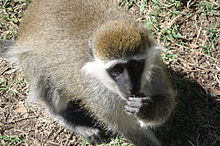- Grivet
-
Grivet[1] 
Conservation status Scientific classification Kingdom: Animalia Phylum: Chordata Class: Mammalia Order: Primates Family: Cercopithecidae Genus: Chlorocebus Species: C. aethiops Binomial name Chlorocebus aethiops
(Linnaeus, 1758)
Grivet range The grivet (Chlorocebus aethiops) is an Old World monkey with long white tufts of hair along the sides of the face. Some authorities consider this and all of the members of the genus Chlorocebus to be a single species, Cercopithecus aethiops.[1] As here defined, the grivet is restricted to Ethiopia, Sudan, Djibouti and Eritrea.[2] In the southern part of its range it comes into contact with the closely related vervet monkey (C. pygerythrus) and Bale Mountains vervet (C. djamdjamensis).[3] Hybridization between them is possible, and may present a threat to the vulnerable Bale Mountains Vervet.[3] Unlike that species, the Grivet is common and rated as Least Concern by the IUCN.[2]
Contents
Characteristics
The grivet's facial skin, hands, and feet are black. The face has a white line above the eyes. It has long white whiskers on the cheeks. The fur on the back has an olive color while the front is white fur. The skin on the stomach has a blue tint. The fur has a bristly feel. The approximate head to body length for males is 19.5 inches or 49 centimeters for males and females with a shorter distance of 17 inches or 42.5 centimeters. The length of the tail for males is approximately 22 inches or 56 centimeters. The body mass ranges from 3 to 5 kilograms or approximately for males is 9 pounds 6 ounces or 4.25 kilograms and for smaller females it is 6 pounds 10 ounces or 3 kilograms. It travels in packs and usually moves on all fours or quadrupedally except when using both hands for carrying, when it manages to walk and run quite comfortably on two legs. Groups can range from 5 to even 70 or higher.[4]
Habitat
The main habitat of the grivet is savanna woodlands.[2] Its range is Sudan east of the White Nile, Eritrea, and Ethiopia east to the Rift Valley.[1] It is also found in Djibouti and Eritrea.[2] The Grivet needs to live around a source of water especially during the dry season. It is able to adapt to many environments.[2]
Behavior
The grivet is most active in the morning and in early evening. It stays on the ground most of the day to eat and at night it sleeps in trees. The Grivet spends a lot of time grooming, playing, climbing, and play fighting; all of these things help to ensure its survival. Its eating habits consist of eating mostly fruits, vegetables, and sometimes small mammals, insects, and birds making it an omnivore. It will also scavenge for human food. It must drink water daily especially in the dry seasons. It is one of few species that has multi-male groups that are of moderate size. There is a hierarchy of males and it shows its dominance by putting its tail in a stiff upright position and strolling past lower ranked males.[citation needed]
Females will have a limited number of mates while males will have numerous. Swelling of the females vulva alerts males as to when the females are in heat. Giving birth to one baby at a time is common and the pregnancy usually lasts 2 to 3 months. When the baby is born the mother will clean the infant and bite off the umbilical cord. Young have a pink face and black hair. It will take around 2 months for them to get their adult coat. The first couple of months the infant will stay very close to its mother, but after 6 months the infant is weaned.[4]
Significance
The grivet is occasionally hunted as bushmeat throughout Africa. They are killed for either commercial or subsistence purposes. Although not endangered, it is threatened through destruction of habitat by way of disappearing forests. It is preyed on by large snakes, leopards, humans and sometimes baboons.[5] The Grivet generally lives 11 to 13 years.[citation needed]
References
- ^ a b c Groves, C. (2005). Wilson, D. E., & Reeder, D. M, eds. ed. Mammal Species of the World (3rd ed.). Baltimore: Johns Hopkins University Press. pp. 158-159. OCLC 62265494. ISBN 0-801-88221-4. http://www.bucknell.edu/msw3/browse.asp?id=12100505.
- ^ a b c d e f Kingdon, J. & Butynski, T. M. (2008). Chlorocebus aethiops. In: IUCN 2008. IUCN Red List of Threatened Species. Downloaded on 4 January 2009.
- ^ a b Kingdon, J. (1997). The Kingdon Guide to African Mammals. Academic Press Limited, London. ISBN 0-12-408355-2.
- ^ a b Cawthon Lang KA (2006-01-03). "Primate Factsheets: Vervet (Chlorocebus) Taxonomy, Morphology, & Ecology". http://pin.primate.wisc.edu/factsheets/entry/vervet. Retrieved 2008-11-12.
- ^ Rochester M (1999). "Chlorocebus aethiops". Animal Diversity Web. http://animaldiversity.ummz.umich.edu/site/accounts/information/Chlorocebus_aethiops.html. Retrieved 2008-11-12.
- "Chlorocebus aethiops", Retrieved on November 10, 2008</ref>
- Adeyemo AI. 1997. Diurnal activities of green monkeys Cercopithecus aethiops in Old Oyo National Park, Nigeria. S Afr J Wildl Res 27(1): 24-6.
- Ashton, E. H., & Zuckerman, S. (1951). The influence of geographic isolation on the skull of the green monkey (cercopithecus aethiops sabaeus). IV. the degree and speed of dental differentiation in the st kitts green monkey. Proceedings of the Royal Society of London.Series B, Biological Sciences, 138(892), 354-374.
Categories:- IUCN Red List least concern species
- Fauna of Burkina Faso
- Fauna of West Africa
- Mammals of Ethiopia
- Mammals of Africa
- Cercopithecine monkeys
- Animals described in 1758
Wikimedia Foundation. 2010.

